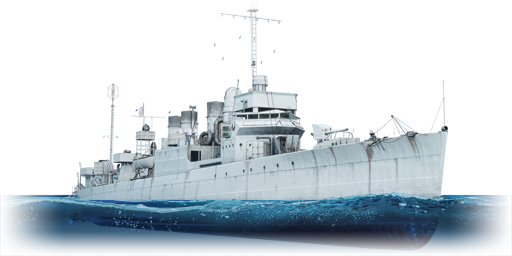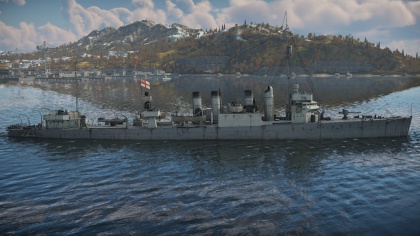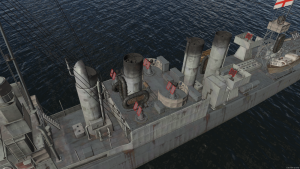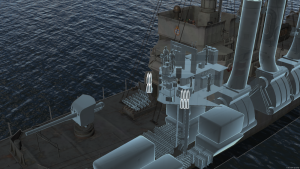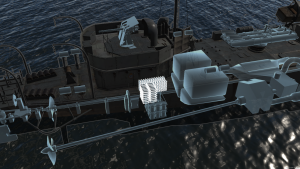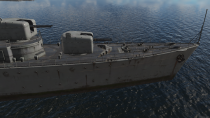Difference between revisions of "HMS Churchill"
(Edits) |
(Tag: Visual edit) |
||
| Line 58: | Line 58: | ||
It won't be able to keep up against most destroyers nor will be able to outrun or outturn many patrol boats. The poor low speed of 50 km/h becomes a concern when attempting to escape enemy salvo or evading some aircraft. | It won't be able to keep up against most destroyers nor will be able to outrun or outturn many patrol boats. The poor low speed of 50 km/h becomes a concern when attempting to escape enemy salvo or evading some aircraft. | ||
| − | The wide turn radius does not help her at all, which leads to exposing the Churchill longer than it should. Curiously this trait was despised by its real captains which noted how the turn radius was similar to the Royal Navy's battleships; misfortunate indeed. | + | The wide turn radius does not help her at all, which leads to exposing the Churchill longer than it should. Curiously this trait was despised by its real-life captains which noted how the turn radius was similar to the Royal Navy's battleships; misfortunate indeed. |
When torpedo attacked, captains must manoeuvre skillfully and in anticipation; keeping in mind the torpedo will always go faster than the Churchill, and the plane is also more agile and faster than the Churchill. | When torpedo attacked, captains must manoeuvre skillfully and in anticipation; keeping in mind the torpedo will always go faster than the Churchill, and the plane is also more agile and faster than the Churchill. | ||
| Line 78: | Line 78: | ||
The anti-air purpose of this gun is very limited, because of the poor gun elevation and slow turret traverse. The advised shell for anti-air is the shrapnel, but the offensive use as anti-air of this gun should be avoided and in a dangerous situation, limited to very low flying aircraft. | The anti-air purpose of this gun is very limited, because of the poor gun elevation and slow turret traverse. The advised shell for anti-air is the shrapnel, but the offensive use as anti-air of this gun should be avoided and in a dangerous situation, limited to very low flying aircraft. | ||
| − | The '''BL Mark IX ( | + | The '''BL Mark IX (102 mm)''' can use 3 types of ammunition: |
* '''4 inch HE Shell (High Explosive)''': Captains should use this as main ammo, it carries the most explosive mass and offers the best damage input for unarmoured ships. | * '''4 inch HE Shell (High Explosive)''': Captains should use this as main ammo, it carries the most explosive mass and offers the best damage input for unarmoured ships. | ||
* '''4 inch SAP (Semi-armour piercing)''': Must be equipped to deal with heavy armour, notably some Soviet boats. Not recommended to general-purpose due to overpenetration<ref>'''<u>Overpenetration</u>''' refers to the ability of some AP, APCBC or SAP shells to '''go through the target''' causing minimal damage. Essentially because of the lack of thick armour or components to detonate the fuze of the shell.</ref>. | * '''4 inch SAP (Semi-armour piercing)''': Must be equipped to deal with heavy armour, notably some Soviet boats. Not recommended to general-purpose due to overpenetration<ref>'''<u>Overpenetration</u>''' refers to the ability of some AP, APCBC or SAP shells to '''go through the target''' causing minimal damage. Essentially because of the lack of thick armour or components to detonate the fuze of the shell.</ref>. | ||
* '''4 inch Shrapnel''': Lethal decimating crew, conical pinpoint damage to modules; it can generate an airburst of shrapnel. Effective for small boats but less damage input than HE. | * '''4 inch Shrapnel''': Lethal decimating crew, conical pinpoint damage to modules; it can generate an airburst of shrapnel. Effective for small boats but less damage input than HE. | ||
| + | |||
| + | {{Notice | ||
| + | |Don't forget training the gunners' skills for faster reload in the main gun | ||
| + | }} | ||
=== Secondary armament === | === Secondary armament === | ||
| Line 89: | Line 93: | ||
''Some ships are fitted with weapons of various calibres. Secondary armaments are defined as weapons chosen with the control <code>Select secondary weapon</code>. Evaluate the secondary armaments and give advice on how to use them. Describe the ammunition available for the secondary armament. Provide recommendations on how to use them and which ammunition to choose. Remember that any anti-air armament, even heavy calibre weapons, belong in the next section. If there is no secondary armament, remove this section.'' | ''Some ships are fitted with weapons of various calibres. Secondary armaments are defined as weapons chosen with the control <code>Select secondary weapon</code>. Evaluate the secondary armaments and give advice on how to use them. Describe the ammunition available for the secondary armament. Provide recommendations on how to use them and which ammunition to choose. Remember that any anti-air armament, even heavy calibre weapons, belong in the next section. If there is no secondary armament, remove this section.'' | ||
| + | |||
| + | The auxiliary armament of the HMS Churchill consists of a sole 3 inch naval AA Mk.V (76 mm) gun. The only shell available is the HE. | ||
| + | |||
| + | This gun is intended to act as anti-air fire, however, it is fairly ineffective. It requires a direct hit to any plane. A big plane that must be flying slow and in a straight line. So the use of this gun as anti-air is a situational and not under regular circumstances. | ||
| + | |||
| + | This gun does perform well as an auxiliary role against small boats. This gun is faster in targeting and reload than the main gun. Hence it can serve as a backup heavy-hitting gun filled with okay explosive mass if the main gun gets knocked out. | ||
=== Anti-aircraft armament === | === Anti-aircraft armament === | ||
| Line 175: | Line 185: | ||
== Media == | == Media == | ||
| − | + | <!-- Excellent additions to the article would be video guides, screenshots from the game, and photos. --> | |
| + | {{Youtube-gallery|Zt6JJt5uYgs|War Thunder's video talks about how the HMS Churchill performs against other reserve destroyers}} | ||
| + | |||
| + | == See also ==<!-- Links to articles on the War Thunder Wiki that you think will be useful for the reader, for example: | ||
| + | |||
| + | reference to the series of the ship; | ||
| + | links to approximate analogues of other nations and research trees. --> | ||
| + | |||
| + | Shared operational history | ||
| + | |||
| + | * '''[[Montgomery (G95)|HMS Montgomery (G95)]]''' | ||
| + | |||
| + | '''Related development''' | ||
| + | |||
| + | * '''[[Montgomery (G95)|HMS Montgomery (G95)]]''' | ||
| + | * [[USS Welborn (DD-195)|Clemson (DD-195) USS Welborn]] | ||
| + | * [[Clemson (DD-213)|Clemson (DD-213) USS Barker]] | ||
| + | * [[Clemson (DD-336)|Clemson (DD-336) USS Litchfield]] | ||
| + | |||
| + | Analogues on other nations | ||
| − | + | * [[Frunze]] (USRR) | |
| − | + | * [[IJN Mutsuki]] (Japan) | |
| + | * [[Turbine]] (Italy) | ||
| + | * [[Type 1924 Leopard]] (Germany) | ||
| − | + | == External links ==<!-- Paste links to sources and external resources, such as: | |
| − | |||
| − | + | topic on the official game forum; | |
| − | + | encyclopedia page on ship; | |
| + | other literature. --> | ||
| − | * '' | + | * ''Chronology of the War at Sea, 1939-1945'': The Naval History of World War Two, Rohwer & Hummelchen (1992) pp.135 & 139 |
| − | * '' | + | * ''British & dominion: Warships of World War II'', Lenton & Colledge (1968) pp.92–94 |
| − | * | + | * https://en.wikipedia.org/wiki/Town-class_destroyer |
| + | * https://en.wikipedia.org/wiki/USS_Herndon_(DD-198)#HMS_Churchill | ||
| + | * https://forum.warthunder.com/index.php?/topic/453336-hms-churchill/ (Forum discussion about the HMS Churchill) | ||
{{Britain destroyers}} | {{Britain destroyers}} | ||
<references /> | <references /> | ||
Revision as of 00:59, 11 December 2020
Contents
| This page is about the British destroyer HMS Churchill (L45). For other vessels of the class, see Clemson-class. |
Description
The Town-class, HMS Churchill (I45), 1942 is a rank I British destroyer
with a battle rating of 3.3 (AB/RB/SB). It was introduced in Update 1.83 "Masters of the Sea" as part of the British fleet closed beta test. It is the first destroyer in the British Bluewater fleet.
The HMS Churchill part of the Town class is a destroyer provided to the Royal Navy by the United States Navy during the early stages of World War II. Not really envisaged and fitted for destroyer versus destroyers engagements, but as escort destroyer. The Town class served primarily on this role over the Atlantic, fighting against the Luftwaffe and the soundless but seemingly omnipresent Wolfpacks of the German U-boats (U-Boots).
In the game, this vessel performs best defensively, as it lacks sufficient armament to stand against better-armed reserve[1] destroyers. It turns into an unstoppable mammoth capable to win games among low-rank fast boats but it becomes into a trifling and soft prey among high-rank destroyers.
Fundamentally, The HMS Churchill is on troubles facing anything bigger than her, so British aspiring captains must be patient and play smartly if they want to achieve success in this ship.
General info
The HMS Churchill can be recognised as light or auxiliary destroyer; this is because is not armed with many significative main armaments. Instead is armed with smaller automatic cannons which become useful against aircraft or small boats. The speed and armour are very limited and often, won't be the defining factor for its survival.
When compared with other reserve destroyers, it does not performs similarly.
Survivability and armour
HMS Churchill's survivability is below average because of the crew complement being only of 143. With the average destroyer crew size among all nation's rank I being 183. This means Captains should not rely on crew durability to win duels with other destroyers; Churchill is likely to lose them.
The armour present on the ship is limited to the gun turrets' shielding. This is effective to shield the rate of fire since the guns will be more protected against shrapnel and HE shells. Yet, is ineffective against armour piercing rounds (AP), HE with base fuse[2] (present on most German destroyers) and even aircraft fire. Small patrol boats with Heavy machine guns (12.7 mm) or automatic cannons are also able to knock out the turrets with the facility.
The position of the sole main gun in the bow of the ship, allows the HMS Churchill to remain in the fight with the relatively concealed secondary machine guns in a superstructure behind the bridge. This is where the concentration of Churchill's firepower is placed.
Armour
The armour plates available on the Churchill are made of Antifragmentation armour. 4.97 mm armour plates cover the main and secondary/auxiliary guns located at the bow and stern. The most armed area of the Churchill is protected by individual plates of 12.7 mm of anti-fragmentation armour covering each anti-air turret.
The HMS Churchill's hull is made of 16 mm of steel while the superstructure is protected by only 4 mm steel.
This armour won't provide significative protection against most of the destroyer's main calibre shells (100 mm +). The hull armour is only practical against 12.7 mm or less.
Ammo racks
The bow[3] is one of the most dangerous zones of the ship. Here the ready ammo racks are enclosed by a steel box and located next to the Hedgehog mortar charges just behind where the main turret is placed. Enemy ships might attempt to knock the single main gun but end up hitting the ready ammo, causing the fatal detonation of these. Unfortunately, just below the ready ammo racks, is located a huge stash of ammo. This storage might detonate by the direct hit or the close impact of a powerful enough HE shell with a base fuse.
On the positive side, this ammo rack is hidden below the waterline[4] and between big fuel tanks. Those fuel tanks offer adequate protection against hits from the bow. So an ammo rack detonation is rare.
The second most dangerous zone being the stern [5]of the ship. Here the majority of the explosives is settled. Depth charges are scattered everywhere; just below them, an ammo rack is located with even more depth charges. This ammo rack is poorly protected when compared with the main ammo rack, so captains should conceal it properly. Near there is also the torpedoes which only are protected by torpedo tubes.
Because of the big length and not so great mobility of the ship, this rear area is often hit by torpedoes which results in a fatal blow for the HMS Churchill.
Mobility
The mobility of the HMS Churchill is in recap, incompetent.
It won't be able to keep up against most destroyers nor will be able to outrun or outturn many patrol boats. The poor low speed of 50 km/h becomes a concern when attempting to escape enemy salvo or evading some aircraft.
The wide turn radius does not help her at all, which leads to exposing the Churchill longer than it should. Curiously this trait was despised by its real-life captains which noted how the turn radius was similar to the Royal Navy's battleships; misfortunate indeed.
When torpedo attacked, captains must manoeuvre skillfully and in anticipation; keeping in mind the torpedo will always go faster than the Churchill, and the plane is also more agile and faster than the Churchill.
| Mobility Characteristics | |||
|---|---|---|---|
| Game Mode | Upgrade Status | Maximum Speed (km/h) | |
| Forward | Reverse | ||
| AB | |||
| Upgraded | 61 | 26 | |
| RB/SB | |||
| Upgraded | 50 | 22 | |
Armament
Primary armament
The ship is armed with a single BL Mark IX (102 mm) medium-velocity breech-loading gun. This gun is the biggest aboard the destroyer, however, is not the most lethal. The gun is located at the bow of the ship, just ahead of the bridge.
This gun was meant to engage light targets like submarines and motor gunboats like the German E-boats (S-100 (S204), S-100 (1945), S-100 (1944)). It performs okay against armoured boats and small corvettes, but it struggles to cause meaningful damage to many destroyers or fast small boats. This is because of the poor explosive filler and just being one gun.
Because of that low explosive amount, the shell won't trigger any hull break[6] on small boats. This is really critical and inefficient since several consecutive shots will be needed for a single small boat that will not be destroyed, no matter how small it is. The helpful aspect of this gun is the great reload rate of 12 rounds/min and once the ready ammo rack has been spent, the fire rate remains on 10 rounds/min. The gun maintains decent ballistics[7] because of an appropriate muzzle velocity of 805 m/s. This facilitates the leading of the targets as well as the short-medium distances shooting (500-4,000m); quite easy to get used to it since at short ranges it's almost a completely flat trajectory.
The anti-air purpose of this gun is very limited, because of the poor gun elevation and slow turret traverse. The advised shell for anti-air is the shrapnel, but the offensive use as anti-air of this gun should be avoided and in a dangerous situation, limited to very low flying aircraft.
The BL Mark IX (102 mm) can use 3 types of ammunition:
- 4 inch HE Shell (High Explosive): Captains should use this as main ammo, it carries the most explosive mass and offers the best damage input for unarmoured ships.
- 4 inch SAP (Semi-armour piercing): Must be equipped to deal with heavy armour, notably some Soviet boats. Not recommended to general-purpose due to overpenetration[8].
- 4 inch Shrapnel: Lethal decimating crew, conical pinpoint damage to modules; it can generate an airburst of shrapnel. Effective for small boats but less damage input than HE.
| Don't forget training the gunners' skills for faster reload in the main gun |
Secondary armament
Some ships are fitted with weapons of various calibres. Secondary armaments are defined as weapons chosen with the control Select secondary weapon. Evaluate the secondary armaments and give advice on how to use them. Describe the ammunition available for the secondary armament. Provide recommendations on how to use them and which ammunition to choose. Remember that any anti-air armament, even heavy calibre weapons, belong in the next section. If there is no secondary armament, remove this section.
The auxiliary armament of the HMS Churchill consists of a sole 3 inch naval AA Mk.V (76 mm) gun. The only shell available is the HE.
This gun is intended to act as anti-air fire, however, it is fairly ineffective. It requires a direct hit to any plane. A big plane that must be flying slow and in a straight line. So the use of this gun as anti-air is a situational and not under regular circumstances.
This gun does perform well as an auxiliary role against small boats. This gun is faster in targeting and reload than the main gun. Hence it can serve as a backup heavy-hitting gun filled with okay explosive mass if the main gun gets knocked out.
Anti-aircraft armament
An important part of the ship's armament responsible for air defence. Anti-aircraft armament is defined by the weapon chosen with the control Select anti-aircraft weapons. Talk about the ship's anti-air cannons and machine guns, the number of guns and their positions, their effective range, and about their overall effectiveness – including against surface targets. If there are no anti-aircraft armaments, remove this section.
Torpedo armament
Torpedo launchers are standard equipment on many ships and boats. Torpedoes are a significant means of defeating an opponent. Evaluate the position of the torpedo launchers, discuss the ammunition available, firing specifics such as dead zones, features of the torpedoes themselves, etc. If there is no torpedo armament, remove this section.
Special armament
Depth charges, mines, rocket launchers and missiles are also effective in skilled hands and can take an off-guard opponent by surprise. Evaluate the ammunition of this type of armament and rate its performance in combat. If there are no special armaments, remove this section.
Usage in battles
Describe the technique of using this ship, the characteristics of her use in a team and tips on strategy. Abstain from writing an entire guide – don't try to provide a single point of view, but give the reader food for thought. Talk about the most dangerous opponents for this vehicle and provide recommendations on fighting them. If necessary, note the specifics of playing with this vehicle in various modes (AB, RB, SB).
Modules
| Tier | Seakeeping | Unsinkability | Firepower | |||
|---|---|---|---|---|---|---|
| I | Dry-Docking | Tool Set | 4 inch SAP | Anti-Air Armament Targeting | ||
| II | Rudder Replacement | Fire Protection System | Smokescreen | 102 mm shrapnel | Auxiliary Armament Targeting | |
| III | Propeller Replacement | Ventilation | Shrapnel Protection | Primary Armament Targeting | Improved Rangefinder | |
| IV | Engine Maintenance | New Pumps | Ammo Wetting | Torpedo Mode | Bomb mortar | |
Pros and cons
Pros:
- Great amount of anti-air guns; perform well against boats and planes
- Hight amount of additional armaments: Torpedoes, depth charges and Hedgehog mortars
- Narrow hull allows for an incursion in small boat's area
- Useful penetration of the main gun's SAP round; useful for heavily armoured ships as the Kanonenboot K-2 or MBK-161 (1943)
- Reliable reload rate of the main gun
Cons:
- Quite slow; it lags behind most other Rank I destroyers
- A single main gun is ineffective; it also lacks HE filler to do any major damage
- Secondary gun is futile against destroyers; even less explosive damage input
- Only 3 torpedoes.
- Below average crew size
- Complicate playstyle due to vital insufficiencies (Speed, Firepower and Crew count)
History
Describe the history of the creation and combat usage of the ship in more detail than in the introduction. If the historical reference turns out to be too long, take it to a separate article, taking a link to the article about the ship and adding a block "/History" (example: https://wiki.warthunder.com/(Ship-name)/History) and add a link to it here using the main template. Be sure to reference text and sources by using <ref></ref>, as well as adding them at the end of the article with <references />. This section may also include the ship's dev blog entry (if applicable) and the in-game encyclopedia description (under === In-game description ===, also if applicable).
Media
See also
Shared operational history
Related development
- HMS Montgomery (G95)
- Clemson (DD-195) USS Welborn
- Clemson (DD-213) USS Barker
- Clemson (DD-336) USS Litchfield
Analogues on other nations
- Frunze (USRR)
- IJN Mutsuki (Japan)
- Turbine (Italy)
- Type 1924 Leopard (Germany)
External links
- Chronology of the War at Sea, 1939-1945: The Naval History of World War Two, Rohwer & Hummelchen (1992) pp.135 & 139
- British & dominion: Warships of World War II, Lenton & Colledge (1968) pp.92–94
- https://en.wikipedia.org/wiki/Town-class_destroyer
- https://en.wikipedia.org/wiki/USS_Herndon_(DD-198)#HMS_Churchill
- https://forum.warthunder.com/index.php?/topic/453336-hms-churchill/ (Forum discussion about the HMS Churchill)
| Britain destroyers | |
|---|---|
| Town-class | HMS Churchill · HMS Montgomery |
| V-class | HMS Valhalla · HMS Vega · HMS Verdun |
| G-class | HMS Grafton · ORP Garland |
| Hunt-class | HMS Calpe · HMS Brissenden |
| Tribal-class | HMCS Haida · HMS Eskimo · HMS Mohawk |
| J-class | HMS Jervis |
| K-class | HMS Kelvin |
| N-class | HMAS Nepal |
| Battle-class | HMS Armada · HMS Cadiz · HMAS Tobruk |
| Daring-class | HMS Daring · HMS Diamond · HMS Diana |
- ↑ Reserve is the term used in War Thunder to refer cost-free vehicles which are only present early in Rank I.
- ↑ Base fuze is a type of HE shell that won't detonate upon impact like the regular HE. Because of an increased fuze sensibility, it penetrates a volume of armour then detonates.
- ↑ Bow is the naval term to the frontal or most forward section of a ship's hull; Is comprised also by the prow and the stem.
- ↑ Waterline is the naval term referring to the meet of the hull and water's surface. This also refers to the different colour markings on the hull to provide useful buoyancy data.
- ↑ Stern is a naval term referring to the back end section of a naval vessel which is most opposite from the bow. Is comprised also by the transom
- ↑ Hull break is a game mechanic in War Thunder in which a direct hit of a powerful naval gun with more than 100 mm calibre and enough blast force (explosive mass), causes a fatal explosion; destroying the boat violently.
- ↑ Ballistics refers mainly to the ability of the gun to fire a shell towards greater distances (Range), keeping a preferable flat and not parabolic trajectory, a small-time of flight of the shell and keeping adequate penetration values at long distances.
- ↑ Overpenetration refers to the ability of some AP, APCBC or SAP shells to go through the target causing minimal damage. Essentially because of the lack of thick armour or components to detonate the fuze of the shell.


